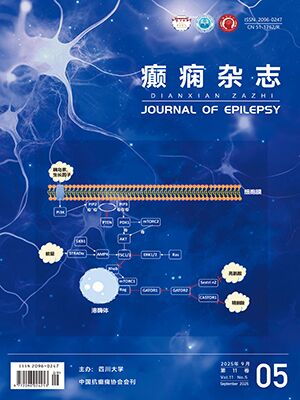| 1. |
Nguyen DK, Mbacfou MT, Nguyen DB, et al. Prevalence of nonlesional focal epilepsy in an adult epilepsy clinic. Can J Neurol Sci, 2013, 40(2): 198-202.
|
| 2. |
Téllez-Zenteno JF, Hernández Ronquillo L, Moien-Afshari F, et al. Surgical outcomes in lesional and non-lesional epilepsy: a systematic review and meta-analysis. Epilepsy Res, 2010, 89(2-3): 310-318.
|
| 3. |
Wang S, Tang Y, Aung T, et al. Multimodal noninvasive evaluation in MRI-negative operculoinsular epilepsy. J Neurosurg, 2019, 132(5): 1334-1344.
|
| 4. |
Suller Marti A, Mirsattari SM, MacDougall K, et al. Vagus nerve stimulation in patients with therapy-resistant generalized epilepsy. Epilepsy Behav, 2020, 111: 107253.
|
| 5. |
Specchio N, Ferretti A, Pietrafusa N, et al. Refractory status epilepticus in genetic epilepsy-is vagus nerve stimulation an option? Front Neurol, 2020, 11: 443.
|
| 6. |
McHugh JC, Singh HW, Phillips J, et al. Outcome measurement after vagal nerve stimulation therapy: proposal of a new classification. Epilepsia, 2007, 48(2): 375-378.
|
| 7. |
Soleman J, Stein M, Knorr C, et al. Improved quality of life and cognition after early vagal nerve stimulator implantation in children. Epilepsy Behav, 2018, 88: 139-145.
|
| 8. |
Elliott RE, Morsi A, Kalhorn SP, et al. Vagus nerve stimulation in 436 consecutive patients with treatment-resistant epilepsy: long-term outcomes and predictors of response. Epilepsy Behav, 2011, 20(1): 57-63.
|
| 9. |
Burakgazi AZ, Burakgazi-Dalkilic E, Caputy AJ, et al. The correlation between vagus nerve stimulation efficacy and partial onset epilepsies. J Clin Neurophysiol, 2011, 28(4): 380-383.
|
| 10. |
Wang X, Zhang C, Wang Y, et al. Prognostic factors for seizure outcome in patients with MRI-negative temporal lobe epilepsy: A meta-analysis and systematic review. Seizure, 2016, 38: 54-62.
|
| 11. |
Lee SK, Lee SY, Kim KK, et al. Surgical outcome and prognostic factors of cryptogenic neocortical epilepsy. Ann Neurol, 2005, 58(4): 525-32.
|
| 12. |
Morris GL, Mueller WM. Long-term treatment with vagus nerve stimulation in patients with refractory epilepsy. The Vagus Nerve Stimulation Study Group E01-E05. Neurology, 1999, 53(8): 1731-1735.
|
| 13. |
Toffa DH, Touma L, El Meskine T, et al. Learnings from 30 years of reported efficacy and safety of vagus nerve stimulation (VNS) for epilepsy treatment: a critical review. Seizure, 2020, 83: 104-123.
|
| 14. |
Renfroe JB, Wheless JW. Earlier use of adjunctive vagus nerve stimulation therapy for refractory epilepsy. Neurology, 2002, 59(6 Suppl 4): S26-30.
|
| 15. |
Liu S, Xiong Z, Wang J, et al. Efficacy and potential predictors of vagus nerve stimulation therapy in refractory postencephalitic epilepsy. Ther Adv Chronic Dis, 2022, 13: 20406223211066738.
|
| 16. |
Kavčič A, Kajdič N, Rener-Primec Z, et al. Efficacy and tolerability of vagus nerve stimulation therapy (VNS) in Slovenian epilepsy patients: younger age and shorter duration of epilepsy might result in better outcome. Acta Clin Croat, 2019, 58(2): 255-264.
|




